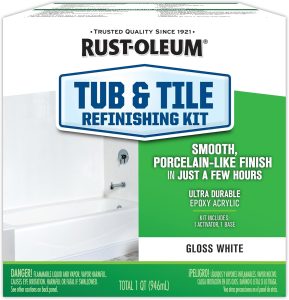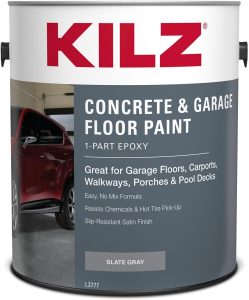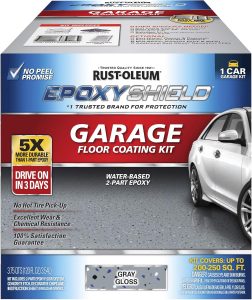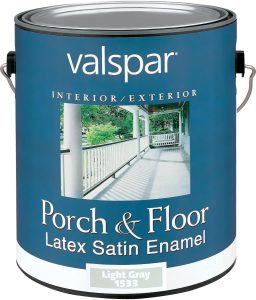Tile floors are a durable and attractive option for many homes, but over time, even the most beautiful tiles can start to show signs of wear. Whether your tiles are chipped, stained, or outdated, replacing them entirely can be a costly and time-consuming process. Luckily, there’s a solution that can save you time and money: floor tile paint. With the right paint, you can breathe new life into your floors and give them a fresh, modern look.
We’ll explore everything you need to know about choosing the best floor tile paint for your needs. From what types of paint work best on tiles to how to properly prepare your surfaces and apply the paint for optimal results, this guide will help you get the perfect finish for your floors.
Why Paint Your Floor Tiles?
Before diving into the best tile paints available, let’s first understand why you might consider painting your floor tiles in the first place.
- Cost-Effective: Replacing floor tiles can be expensive, especially if you need to replace a large area. Painting your tiles is a fraction of the cost, making it an attractive option for homeowners on a budget.
- Customization: Floor tile paint gives you the freedom to choose from a variety of colors and finishes. You can easily change the entire look of your floor, giving your space a fresh, updated vibe.
- Less Messy and Time-Consuming: Replacing tiles involves a lot of demolition work and can take days to complete. With floor tile paint, you can get the job done in a matter of hours, and there’s significantly less mess involved.
- Durability: Quality tile paint can withstand high foot traffic, moisture, and even cleaning products, providing a durable finish that will last for years.
- Eco-Friendly Option: If your tiles are in good condition but just look outdated, painting them can be an eco-friendly solution. You’ll reduce waste by not having to throw out the old tiles.
Types of Floor Tile Paint
When it comes to painting your floor tiles, you can choose from several different types of paint. The best option for your project will depend on the type of tile you’re working with, the area being painted, and your desired results.
1. Epoxy Paint
Epoxy is one of the most durable and versatile options for floor tile paint. It consists of two parts: a resin and a hardener that, when mixed, form a strong, long-lasting bond. Epoxy paint is resistant to moisture, stains, and wear, making it ideal for high-traffic areas such as kitchens, bathrooms, and hallways.
Pros:
- Highly durable and resistant to wear.
- Waterproof and stain-resistant.
- Offers a shiny, smooth finish.
Cons:
- Requires mixing two components, which can be a bit tedious.
- Can be challenging to apply and requires precise preparation.
2. Acrylic Paint
Acrylic paint is another popular option for floor tiles, particularly for those looking for a more user-friendly, low-maintenance solution. It adheres well to ceramic and porcelain tiles, offering excellent flexibility. With a wide range of color options, it allows for creative customization to suit any style. While not as durable as epoxy, it can still withstand moderate foot traffic and is ideal for lighter-use areas like bedrooms or living rooms.
Pros:
- Easy to apply and clean up.
- Available in a wide range of colors.
- Quick-drying.
Cons:
- Not as durable as epoxy, especially in high-traffic areas.
- Can be prone to chipping or scratching over time.
3. Chalk Paint
Chalk paint is becoming increasingly popular for tile projects due to its ability to adhere to almost any surface without much prep work. It provides a matte, vintage look and can be sealed for added protection, making it both stylish and practical. This option works best for decorative or accent areas rather than high-traffic floors.
Pros:
- Minimal surface preparation required.
- Ideal for vintage or shabby-chic looks.
- Easy to distress or touch up.
Cons:
- Needs to be sealed for durability.
- Can get dirty easily if not sealed properly.
4. Oil-Based Paint
Oil-based paints are incredibly durable and offer a smooth, glossy finish. They are resistant to moisture, which makes them an excellent option for bathrooms and kitchens. However, they take longer to dry and may have a stronger odor, so proper ventilation is necessary.
Pros:
- Smooth, glossy finish.
- Very durable, ideal for high-traffic areas.
- Moisture-resistant.
Cons:
- Strong odor during application.
- Longer drying time compared to other paints.
- Requires proper ventilation.
Top Floor Tile Paints for 2025
Now that we’ve covered the different types of paint, let’s take a look at some of the best floor tile paints available on the market. These paints are highly rated for their durability, ease of use, and ability to deliver a smooth, long-lasting finish.
1. Rust-Oleum Tub & Tile Refinishing Kit

Rust-Oleum is a trusted name in the paint industry, and its Tub & Tile Refinishing Kit is one of the best choices for ceramic tile floors. This epoxy-based product can be used to transform old, dull tiles into a glossy, like-new surface. It’s particularly great for bathrooms and kitchens.
Key Features:
- Epoxy-based formula for superior adhesion.
- Offers a durable, shiny finish.
- Resistant to water, stains, and soap scum.
- Available in a white color, ideal for refreshing dated tiles.
Best For: Bathrooms, kitchens, and high-moisture areas.
2. KILZ 1-Part Epoxy Acrylic Interior/Exterior Floor Paint

KILZ is another reputable brand known for its high-quality paints, and their 1-Part Epoxy Acrylic Floor Paint is perfect for floor tiles. This paint is easy to apply and provides excellent coverage with a durable finish. It’s ideal for both indoor and outdoor use and can withstand high foot traffic.
Key Features:
- One-part formula, easy to use with no mixing required.
- Durable and resistant to scuffing and staining.
- Dries quickly and is available in multiple colors.
Best For: High-traffic areas, both indoors and outdoors.
3. NuCore Epoxy Floor Coating Kit

NuCore’s Epoxy Floor Coating Kit is an excellent choice for those who want to achieve a high-end, professional look for their floor tiles. This kit includes everything you need for a complete application, including epoxy resin, hardener, and applicators.
Key Features:
- High-gloss finish that mimics the look of brand-new tile.
- Resistant to chemicals, oil, and water.
- Includes everything needed for easy application.
Best For: Kitchens, garages, and industrial settings.
4. Behr Premium Porch & Patio Floor Paint

While not specifically designed for tiles, Behr’s Premium Porch & Patio Floor Paint is an excellent choice for those looking to refresh outdoor or indoor floor surfaces. This acrylic paint is weather-resistant, durable, and offers a smooth, long-lasting finish. It’s perfect for tile floors that are exposed to the elements.
Key Features:
- Durable and resistant to high foot traffic and the elements.
- UV-resistant, so it won’t fade or peel easily.
- Offers a smooth, semi-gloss finish.
Best For: Outdoor or high-traffic indoor floors.
5. Valspar Porch, Floor, and Patio Latex Paint

Valspar’s Porch, Floor, and Patio Paint is another top contender for tile floors. This high-quality latex paint is great for both indoor and outdoor tile surfaces. It dries quickly, resists dirt and stains, and provides a long-lasting finish.
Key Features:
- Dries quickly and is easy to clean.
- Provides a durable finish that resists wear and tear.
- Available in a variety of colors.
Best For: Outdoor areas and high-traffic zones.
How to Paint Floor Tiles: Step-by-Step Guide
If you’ve decided to give your tiles a fresh new look, it’s important to follow the proper steps to ensure the paint adheres well and provides a long-lasting finish. Here’s a step-by-step guide to painting your floor tiles:
1. Clean the Tiles Thoroughly
Begin by cleaning your tiles to remove dirt, grime, grease, and other contaminants. Use a tile cleaner or a mix of vinegar and water to ensure the surface is as clean as possible. Let the tiles dry completely before proceeding.
2. Sand the Tiles (If Necessary)
Some paints, especially epoxy-based ones, may require you to sand the tiles lightly to create a rough surface for the paint to adhere to. Use a fine-grit sandpaper (around 220-grit) and sand each tile lightly. Wipe away any dust with a clean cloth.
3. Apply Primer
While some tile paints don’t require a primer, it’s always a good idea to use one to improve adhesion and durability. Choose a primer specifically designed for tile or smooth surfaces. Apply a thin, even coat and allow it to dry completely.
4. Apply the Tile Paint
Once the primer has dried, it’s time to apply the paint. Use a paintbrush or roller for smaller areas, and a spray can for larger tiles or areas. Apply the paint in thin, even coats, allowing each coat to dry completely before applying the next.
5. Seal the Paint
After the paint has dried completely, apply a clear polyurethane or tile sealer to protect the surface from scratches, stains, and moisture. Be sure to follow the manufacturer’s instructions for the sealer.
6. Allow to Dry and Cure
Give the painted tiles at least 24 to 48 hours to dry and fully cure before using the area.
Frequently Asked Questions
1. Can I paint my bathroom floor tiles?
Yes, you can paint bathroom floor tiles. It’s important to use an epoxy-based paint or a paint specifically formulated for high-moisture areas to ensure a long-lasting finish.
2. How long will painted floor tiles last?
The longevity of painted floor tiles depends on the type of paint used, the amount of foot traffic, and how well the tiles are maintained. Epoxy paints can last for several years, while acrylic or chalk paints may need to be touched up after a couple of years.
3. Do I need to sand my tiles before painting?
It’s generally recommended to lightly sand the tiles before painting to help the paint adhere better. However, some paints are designed to be applied directly to clean tiles without sanding.
4. Can I paint tiles in high-traffic areas?
Yes, as long as you use a durable, high-quality paint such as epoxy or acrylic designed for heavy use. Be sure to apply multiple coats and a protective sealer for added durability.
5. Can I paint over grout lines?
Yes, you can paint over grout lines, but it may require extra care and precision to achieve a smooth finish. You can also use a grout pen to refresh the grout lines before or after painting.
6. Do I need to prime my tiles before painting?
Priming is highly recommended for better paint adhesion and long-lasting results. Some tile paints don’t require a primer, but using one can significantly improve the durability of the finish.
7. Can I use regular wall paint for my floor tiles?
No, regular wall paint is not designed to withstand foot traffic and moisture exposure like floor-specific paints are. Always use a paint designed for floor or tile surfaces to ensure the best results.
Conclusion
Painting your floor tiles is a cost-effective and efficient way to refresh the look of your home. By choosing the right paint, preparing the surface properly, and applying it carefully, you can achieve a durable, long-lasting finish that gives your floors a completely new look. Whether you’re tackling the bathroom, kitchen, or any other area, the right floor tile paint can completely transform your space.


Leave a Reply